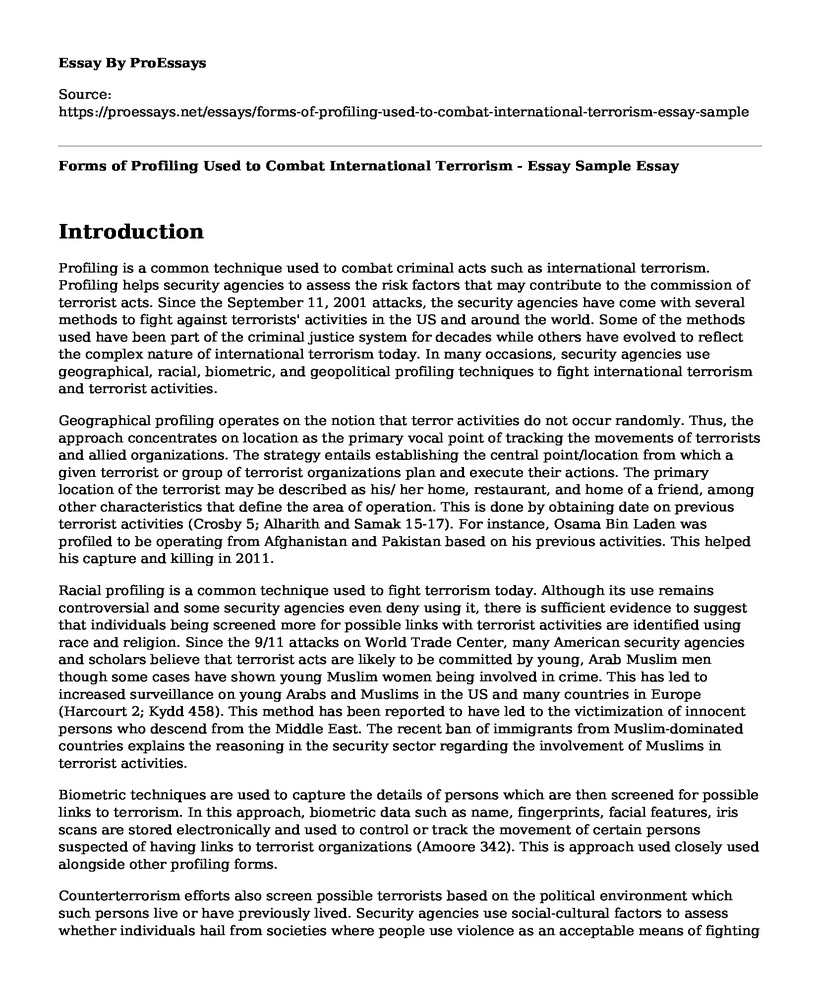Introduction
Profiling is a common technique used to combat criminal acts such as international terrorism. Profiling helps security agencies to assess the risk factors that may contribute to the commission of terrorist acts. Since the September 11, 2001 attacks, the security agencies have come with several methods to fight against terrorists' activities in the US and around the world. Some of the methods used have been part of the criminal justice system for decades while others have evolved to reflect the complex nature of international terrorism today. In many occasions, security agencies use geographical, racial, biometric, and geopolitical profiling techniques to fight international terrorism and terrorist activities.
Geographical profiling operates on the notion that terror activities do not occur randomly. Thus, the approach concentrates on location as the primary vocal point of tracking the movements of terrorists and allied organizations. The strategy entails establishing the central point/location from which a given terrorist or group of terrorist organizations plan and execute their actions. The primary location of the terrorist may be described as his/ her home, restaurant, and home of a friend, among other characteristics that define the area of operation. This is done by obtaining date on previous terrorist activities (Crosby 5; Alharith and Samak 15-17). For instance, Osama Bin Laden was profiled to be operating from Afghanistan and Pakistan based on his previous activities. This helped his capture and killing in 2011.
Racial profiling is a common technique used to fight terrorism today. Although its use remains controversial and some security agencies even deny using it, there is sufficient evidence to suggest that individuals being screened more for possible links with terrorist activities are identified using race and religion. Since the 9/11 attacks on World Trade Center, many American security agencies and scholars believe that terrorist acts are likely to be committed by young, Arab Muslim men though some cases have shown young Muslim women being involved in crime. This has led to increased surveillance on young Arabs and Muslims in the US and many countries in Europe (Harcourt 2; Kydd 458). This method has been reported to have led to the victimization of innocent persons who descend from the Middle East. The recent ban of immigrants from Muslim-dominated countries explains the reasoning in the security sector regarding the involvement of Muslims in terrorist activities.
Biometric techniques are used to capture the details of persons which are then screened for possible links to terrorism. In this approach, biometric data such as name, fingerprints, facial features, iris scans are stored electronically and used to control or track the movement of certain persons suspected of having links to terrorist organizations (Amoore 342). This is approach used closely used alongside other profiling forms.
Counterterrorism efforts also screen possible terrorists based on the political environment which such persons live or have previously lived. Security agencies use social-cultural factors to assess whether individuals hail from societies where people use violence as an acceptable means of fighting against perceived or real injustice. For instance, Palestinians' acceptance of violence as the norm of tactics employed in fighting Israel occupation is a good example of profiling (Dean 177-78). Areas such as Iraq and Afghanistan can also be profiled as having indoctrinated individuals into believing that violence is the best way of achieving justice when one feels oppressed.
Conclusion
In conclusion, geographical profiling puts the operation of specific terrorists in a given region or country or place. Racial profiling screens people based on their Arabic ancestry and affiliation to Islam. Biometric profiling involves capturing electronic data of individuals and tracking them using the data. Moreover, profiling may be done by examining the political environment of an individual as it relates to the glorification of violence as a means of achieving a perceived or real injustice. Although some of the forms of profiling remain unpopular, they continue to be used by security agencies in international counterterrorism efforts.
Works Cited
Alharith, Awatef, and Yasser Samak. "Fighting Terrorism More Effectively with the Aid of GIS: Kingdom of Saudi Arabia Case Study." American Journal of Geographic Information System, vol. 7, no. 1, 2018, pp. 15-31.
Amoore, Louise. "Biometric Borders: Governing Mobilities in the War on Terror." Political Geography, vol. 25, no. 3, 2006, pp. 336-351.
Crosby, Tiffany. "Geographic Profiling: Knowledge Through Prediction." 2014. Monterey, California: Naval Postgraduate School, MA thesis.
Dean, Geoff. "Criminal Profiling in a Terrorism Context." Criminal Profiling, 2007, pp. 169-188.
Harcourt, Bernard E. "Muslim Profiles Post 911: Is Racial Profiling an Effective Counterterrorist Measure and Does it Violate the Right to Be Free from Discrimination?" University of Chicago Law School, 2006, pp. 1-39.
Kydd, Andrew H. "Terrorism and Profiling." Terrorism and Political Violence, vol. 23, no. 3, 2011, pp. 458-473.
Cite this page
Forms of Profiling Used to Combat International Terrorism - Essay Sample. (2022, Jul 15). Retrieved from https://proessays.net/essays/forms-of-profiling-used-to-combat-international-terrorism-essay-sample
If you are the original author of this essay and no longer wish to have it published on the ProEssays website, please click below to request its removal:
- Essay on Understanding Racial Disparity in the US: Examining Conley's 'Being Black, Living in the Red'
- Native Americans: Struggling for Equality & Justice - Research Paper
- Racism: Prejudice, Restrictions & Denial of Rights - Essay Sample
- Women, Guns and Personal Safety: Essay Sample on Linda Hasselstrom's Debate
- Essay Example on Sex and Drug Addiction: Similarities and Differences
- Essay Example on Ruby Bridges: Religion & Civil Rights Movement
- Essay Sample on Tackling Gun-Related Issues in America: The Influence of Lobbying







